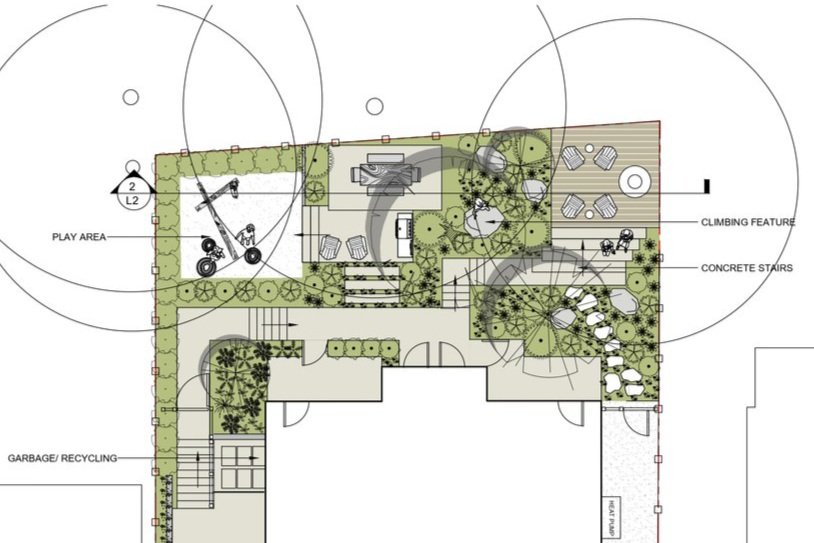Community by Design
Karin Vigonich is an aspiring urban planning student and a new guest contributor to Catalyst. Karin loves to spend her time exploring the trails and mountains of British Columbia and engaging with her community through trail building. She aims to learn how to continue exploring in a sustainable car-free way.
It is commonly reported that one of the challenges of living in a big city is the loneliness and isolation associated with an urban environment. There are various contributors to urban loneliness - architecture, technology, a transient population, etc. – but the fact remains that many of us don’t know our neighbours, despite walking past them every day. Human connection is necessary for our success as a species, and a sense of belonging within our community provides ample health benefits and increases longevity. Through its design, Urban Thrive developments aim to strengthen the connections between its homeowners and the places they share to foster a sense of community.
Not having to plan around car parking, every detail from the placement of stairs to the shared food garden has been designed to create natural and frequent opportunities for neighbours to interact with each other and form social bonds. Without a parking spot in front of each unit (and therefore no opportunity to move quickly and silently between car and home), the projects are designed so that any comings and goings out the front door must use shared paths and sidewalks, allowing for neighbours to casually bump into each other and spark conversation.
2859 Richmond, Allenby Street frontage.
The ability to use the ground level also allows the implementation of wheelchair-accessible entrances, promoting age-in-place homes. This is typically challenging to implement on small multi-family housing projects since the car garage/parking space usually takes up most of the ground level, resulting in split-level homes with difficult accessibility. Accessible entrances promote intergenerational living; the integration of different ages within a housing complex. This is vital for community building, as seniors are the most severely negatively impacted by social isolation due to the likelihood of living alone, loss of loved ones, and mobility issues. Beyond directly improving the health of older adults, intergenerational programming has been shown to improve sense of self-worth and reduce feelings of anxiety in youth. Overall, this is a cyclical effect that ultimately leads to a stronger sense of community.
The rear yard community commons of the Belton Project shows how freeing up (largely dead) space for car parking opens up room for socializing and greenery. In this common space, children can play, people can cook and share a meal, host a party, read a book or simply sit and soak up the sun. The commons is separated into three tiers, allowing both socializing with others or sitting alone with the comfort of having others around.
633 Belton community commons.
The bike garage, aside from functionality, further serves as an opportunity to get to know your neighbours. Lengthier interactions can unfold as residents park their bikes and admire each other's prized sets of wheels- we’re bike people after all! A shared passion for cycling allows for residents to exchange bike tools and knowledge of bike maintenance with each other. This could lead to more openness to sharing other items, such as electrical tools or kitchen gadgets, and as relationships develop, even sharing Modo rides (Costco haul with the neighbours?).
Aside from the social connections built, being a part of such a community could positively influence each individual's sustainability behaviours. Whether the choice to live car-free is primarily an environmental decision or not, all the residents share this common value which has positive environmental implications. Automatic social inclusion within this group could lead to further uptake of environmentally-conscious behaviours by observing your neighbours and developing perceptions of norms. If a handful of the neighbours grow their own food, you might be swayed to learn from the next-door experts! A sense of belonging and access to functional and communal features are likely to contribute to a stronger place attachment for the homeowners, who may be more likely to care for a place to which they feel attached. This could seep through in behaviours such as purchasing decisions, like buying furniture built for durability or eco-friendly cleaning products. In this way, a sense of community could independently motivate individuals to use their purchasing power to make more eco-friendly choices and their social influence to positively persuade others.
Urban Thrive aims to be the catalyst for transitioning towards compact, mixed-use, community-centric neighbourhoods. The car-free design of these homes prioritizes social integration and a sense of community, providing a more healthy and sustainable lifestyle for its residents and an example for the change we need in our city - and around the world.


